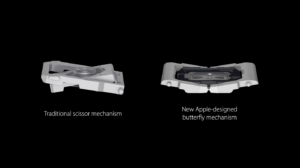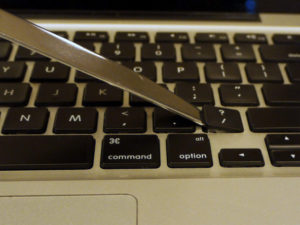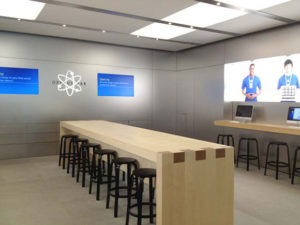The latest uproar on the MacBook Pro’s newly designed keyboard is causing quite a stir. Love it or hate it, the keyboard is the least of my concerns.

Forget politics, if you want to divide a nation, build a computer keyboard. This is especially true if you’re Apple. The famed computer company who’s sole purpose in life seems to out-design the competition has caused quite an uproar with their new keyboards. The new keyboards in question have to do with Apple’s latest computer products dating back to 2016. Prior to 2016, the company used a standard scissor switch key, which basically meant a slightly thicker computer with more key travel. Today, however, the company uses butterfly switches giving the keyboard a lower, flatter profile. Not only is the keyboard thinner, but the keys have less travel and, it would appear, more issues.
I Like This Keyboard

Now before I get into the issues, I want to say that I love the new MacBook Pro. I own a 2017 MacBook Pro 13 inch with Touch Bar and I am in love with this keyboard. I also own a 2009 MacBook Pro with the old scissor keyboard and I have no issues typing on that either. I also own a Lenovo Yoga 710 with a similar keyboard to the 2009 MacBook Pro and again, nothing. But the interesting thing is that I am now so used to typing on the 2017 MacBook Pro, that I can barely go back to the Lenovo or the old Pro. The fact is that key travel is now a problem for me. Ironically enough, it’s more key travel that is an issue for me.
So what’s the problem?
Sadly, key travel is the overarching problem of why people don’t like the new Pro units. On many of occasion, I have heard industry journalists pan the keyboard for its lack of travel. Perhaps these journalists are correct, after all, they type far more than most people do. But for someone like me who sits behind the keyboard all the time, the truth is, I just don’t think I can go back to an older model. The 2017 MacBook Pro has very good tactile feedback and a great clickity-clackity sound when typing. The new travel does require some rewiring in the brain, but it’s very minimal. In the one month that I’ve owned this new laptop, I’ve never felt more at home typing. But I may be alone in this.
A keyboard is like a mattress, not one single comfort level is for everyone. Take the Lenovo 710 Yoga. In my initial tests of that laptop, my biggest complaint was the keyboard. It wasn’t in the key travel, but rather the insanely small right shift key. Overall, it seems that keyboard was well praised by everyone but me. But the butterfly keyboard that Apple has created seems to have a good mix of opinions and controversy.
They break

One complaint about the 2016 butterfly keyboards is that they break. According to Apple Insider (Article link here), the failure rate is nearly twice as much for the 2016 models compared to the 2014 and 2015 models, which feature the old scissor keyboards. And while I have yet to have a problem on my one month old MacBook Pro, the concern is in the back of mind as I know people who have had issues. I spoke to an Apple employee who wished to remain anonymous but this employee told me that certain revisions were made between model years. For example, complaints about dust killing 2016 model keyboards are supposed to be alleviated in new models. While I haven’t been a personal party to this (knock on wood), I have had colleagues who have made similar claims (Check out this CNet Article on dealing with stuck keys). And it’s not just dust as the silent killer of keyboards here. Other reports tell of keys getting stuck or even caught under the top frame of the computer. Once again, this is something I have yet to experience and hope I never will. I’ve only seen one or two of these issues come up in my searching, but apparently this is a thing. A scary thing but a thing none the less.
The numbers

However, as thorough as Apple Insider is in their claims, the one thing to keep in mind is that these percentages do not represent true failure rates. Nor do the stories of failures constitute a mass problem. Rather, the percentages are based on a small sample taken from a Genius Bar. The percentages are based on how many of the total serviced units were brought in for keyboard issues. For example, out of 1402 warranty events, 165 were related to the keyboard. While Apple doesn’t disclose total unit sales by form factor, you have to assume that Apple sold more than 1402 MacBook units. It’s hard to know what the true failure rate is, but it’s not 12%. It’s probably closer to 3% or less. The fact is, as nice as it is to turn the MacBook Pro keyboard into a punching bag, it’s probably wrong to do so if this is really a small issue. However, even if the failure rate is at 12%, the odds are good that most people won’t experience a problem. And the real concern isn’t if they break, but what will Apple do when they do break. Is Apple going to fix them for free? Is the fee going to be nominal like a battery replacement on an iPhone? Right now, the answer is to pray they don’t break, but Apple may change their stance in the future.
So what?
I guess what I’m trying to say is that this whole keyboard situation is overblown and a non-issue for most. I’m not trying to dismiss others who are having issues. I’m simply saying that most people aren’t going to be complaining about the new keyboards. Are newer Apple keyboards failing more than older models? The answer is anecdotally yes and if Apple Insider is to be believed, than absolutely. But a small sample size does not make a mountain out of a molehill. So should it deter you from buying a new MacBook? I’d have to say no. The product is still greatand the chances are good that you may never have a problem. Remember, 2017 models are experiencing fewer issues. Is the keyboard really as bad to use as people say it is? Well, that depends on you. In my opinion, I love this keyboard. I love the authoritative clickity-clackity sound and feel. Am I concerned it may one day break? Absolutely. But so far so good. And because of the lack of evidence to support epidemic failure, the keyboard “issue” isn’t so much an issue as it is a few people complaining (perhaps rightfully) about something that really shouldn’t be breaking.
![[Seeq].TV](https://seeq.tv/wp-content/uploads/2018/05/SEEQ-red-black-copy-3.jpg)



